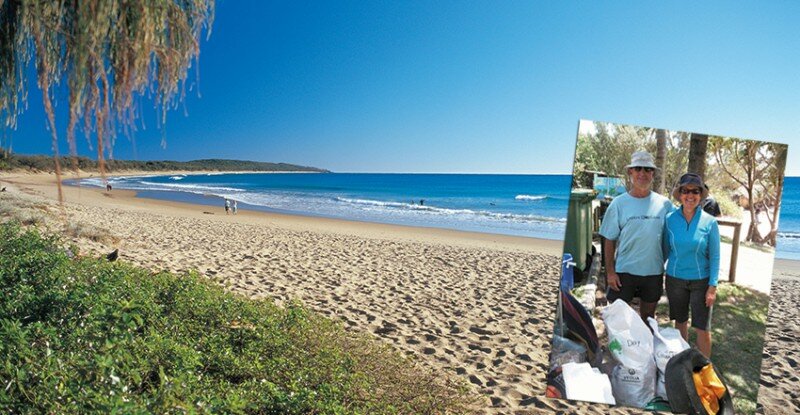Brisbane couple Trish and Lyle Nicholson love to roam Australia and clean up the coastline as they go. TRISH takes up their story…
What inspires someone to spend hours collecting litter from our beaches when they could be relaxing on the beach instead?
For us it’s a combination of things. A concern for the environment, a love of marine wildlife and the aesthetic appeal of pristine beaches.
There’s also a sense of achievement that comes with cleaning up our shore and a feeling of disgust at the laziness of some thoughtless beach users.
Rather than ‘grey nomads’ we describe ourselves as ‘green nomads’ or ‘clean nomads’.
As keen snorkelers and scuba divers, we hate to see any litter that may harm marine life. Plastics are major polluters in our oceans. In 2011, a visit to the turtle hospital at Reef HQ Aquarium in Townsville reinforced to us how even the smallest pieces of plastic litter can cause sickness and sometimes death of turtles and other sea creatures. From there we were inspired to carry a bag or two with us on our regular beach walks to collect litter and dispose of it appropriately. We were surprised at just how much we were collecting daily and how quickly we could make a visible impact on the beaches we patrolled.
Last June we attended Eco Fiesta in Townsville and met Heidi Taylor from Tangaroa Blue Foundation. This not-for-profit organisation coordinates the Australian Marine Debris Initiative which monitors the coastline and provides resources and education to help communities keep them clean.
Heidi provided us with a data sheet so our efforts could be added to a national database. Sorting and counting beach rubbish collected then completing the electronic Tangaroa Blue data sheets made the process more meaningful and productive.
The national data is made widely available and can be used to support the case for preventative actions such as eco-friendly packaging and container deposit systems.
Clean Up Australia Day has been coordinating national clean up events on the first Sunday in March for many years. We’ve participated in cleaning up our local neighbourhood in Brisbane as part of this annual event.
Since 2009, the Great Northern Clean Up has provided northern Australia with an additional opportunity to clean up at a time more suited to a tropical climate.
Last year we registered Horseshoe Bay at Bowen as our site for on the Clean Up after observing lots of litter at this very picturesque little bay during an earlier stay.
During the registered event we collected 999 cigarette butts, 35 plastic drinking straws, 35 plastic drink bottles, 67 metal bottle caps and pull tabs in just two hours. The total weight of rubbish collected was 23kg including a car tyre and a “cats eye” marker from the road.
Disappointment arose when we returned to Horseshoe Bay in the afternoon of our morning clean up event only to find 90 more cigarette butts among other litter at the top of the beach – in spite of the prominent stainless steel “butt out” container and wheelie bins provided by the local council.
How do we get the message through to some people that cigarette butts are litter and that no litter is acceptable on our beaches and in the wider environment? Cigarette butts are not biodegradable, they are full of toxic chemicals and they can be mistaken for food by marine animals.
During our 2012 winter travels we recorded data from beaches around Cooktown, Port Douglas, Mission Beach and Cape Hillsborough. One interesting find in Cherry Tree Bay at Cooktown was remnants of a floating Fish Aggregating Device (FAD) used by fisherman to attract pelagic fish such as tuna, marlin and mahi mahi (dolphin fish). This FAD consisted of a bamboo structure lashed together with nylon rope supporting black plastic and fishing net, floated by a polystyrene bouy.
Unfortunately, fishing nets floating freely in the ocean become ‘ghostnets’, randomly catching unintended species such as turtles, manta rays and dolphins.
Lyle disassembled and carried this structure weighing nearly 20kg over a steep walking track out of Cherry Tree Bay for almost one kilometre to the Grassy Hill car park.
It is satisfying to leave a beach in a better condition that when you arrived – even better to think you may have saved a turtle from “floating syndrome” after consuming plastics, reduced the toxic risk to marine life from cigarette butts or prevented animal entrapment in a ghostnet.
It is enjoyable to walk, swim and dive at pristine beaches without unsightly litter.
Our clean-ups also give us a great opportunity to interact with local communities and contribute to their environment during our brief stay. And hopefully our efforts may influence some to rethink their behaviour.
Clean Up Australia Day 2013 in on Sunday March 3. You can register and be part of a community clean-up near you by going to
www.cleanupaustralia.org.au








